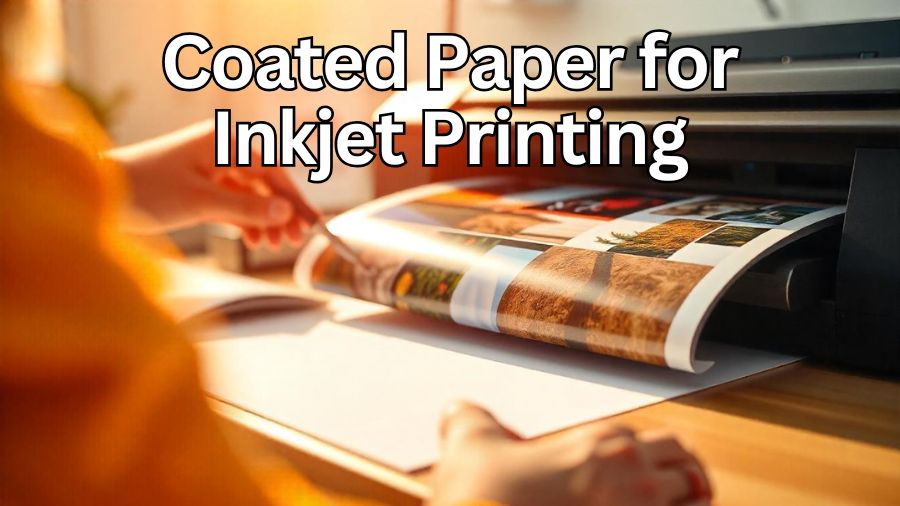Coated paper is a special type of paper used in printing that has a smooth, shiny surface. It is covered with a layer of coating, usually a mix of clay and other materials. This coating helps the ink sit on top of the paper rather than soak into it. As a result, coated paper gives prints sharper details and brighter colors. Many businesses and individuals prefer using coated paper for high-quality prints, like photos, brochures, and flyers.
If you’ve ever noticed how vibrant and clear the colors look on certain photos or printed materials, it’s often because they were printed on coated paper. This paper type makes the images pop, providing a professional, clean finish that regular paper just can’t match. So, if you want your prints to stand out with crisp text and bright, bold colors, choosing coated paper for your inkjet printer is a great decision.
What is Coated Paper?
Coated paper is paper that has a special layer on its surface. This layer is made from materials like clay, which gives the paper a smooth and shiny finish. The coating helps the ink sit on top of the paper, rather than soaking into it. This makes the colors in prints look brighter and more vivid. It also helps produce sharp, clear details, especially in images and text.
Coated paper comes in different finishes. The most common are glossy, matte, and satin. Glossy paper is shiny and reflects light, making photos look vibrant. Matte paper has a smooth, non-reflective surface, making it easier to read text without glare. Satin is a mix of both, with a slight sheen that isn’t too shiny. The coating also helps the ink dry faster, reducing the risk of smudging. This is why coated paper is preferred for high-quality prints like photos, brochures, and posters.
Types of Coated Paper for Inkjet Printing
Coated paper comes in a few different types. Each one is designed for different printing needs. The three most common types are glossy, matte, and satin.
Glossy Coated Paper is the most shiny and reflective. It’s perfect for printing photos because it makes colors look bright and sharp. When you print on glossy paper, the ink stays on top, creating vivid images with a smooth finish. This paper is often used for magazines, posters, and high-quality photo prints.
Matte Coated Paper has a smooth surface, but it doesn’t shine. It’s great for printing documents where readability is important. The lack of gloss makes text easier to read and reduces glare. Many people use matte paper for brochures, flyers, and other professional documents that need to look neat but not too flashy.
Satin Coated Paper offers a slight shine, somewhere between glossy and matte. It gives a soft sheen without being too bright. This paper is often chosen for projects that need a little bit of color pop but don’t need the intense shine of glossy paper. Satin is commonly used for catalogs, art prints, and presentations where a subtle shine is desired.
Each type of coated paper has its own strengths. Depending on your project, you can choose the one that best fits your needs for both look and feel.
Benefits of Using Coated Paper in Inkjet Printers
Using coated paper with an inkjet printer has several important benefits. First, it helps your prints look much sharper and more vibrant. The coating on the paper keeps the ink on the surface, allowing colors to pop. This makes the printout appear clear and crisp, especially for detailed images like photographs.
Second, coated paper prevents the ink from soaking into the paper. This means that the ink stays on top and dries faster. As a result, you avoid smudging and can handle your prints right away. It’s ideal for projects that require high-quality, clean prints, such as marketing materials or photos for a portfolio.
Another key advantage is that coated paper often shows less bleeding. In simple terms, bleeding is when the ink spreads outside the lines, making your print look blurry. With coated paper, ink stays where it’s supposed to, ensuring that text and images are sharp.
Lastly, coated paper is more durable and has a professional look. It gives your prints a more polished finish, which is perfect for items like brochures, flyers, and business cards. This extra touch of quality can help make your materials stand out, whether you’re working on a personal project or business presentation.
Factors to Consider When Choosing Coated Paper
When picking coated paper for your inkjet printer, there are a few important factors to keep in mind. The first thing to consider is the weight and thickness of the paper. Paper weight affects how it feels and how well it holds the ink. Lighter paper is good for everyday prints, while heavier paper gives a more professional, sturdy finish. Heavier paper is often used for projects like business cards or posters.
Next, think about the finish of the paper. Glossy paper makes colors pop and is great for photos, but it can also show fingerprints easily. Matte paper doesn’t have this issue and is great for things like text-heavy documents, but it doesn’t have the same vibrancy as glossy. Satin offers a good balance, with a soft shine that isn’t too reflective.
Also, make sure the paper is compatible with your printer. Not all inkjet printers work well with every type of coated paper. Some printers may struggle with thicker paper, leading to paper jams or uneven ink coverage. Check your printer’s specifications to see what type of paper it can handle.
Finally, consider the environmental impact of your paper choice. Some coated papers are made with eco-friendly materials and processes. If you want a greener option, look for papers that are FSC-certified or made from recycled materials. This way, you can print high-quality materials while also being mindful of the environment.
By considering these factors, you can choose the perfect coated paper for your printing needs, ensuring great results every time.

Printing Tips for Coated Paper
Printing on coated paper requires a little extra care to get the best results. First, adjust your printer settings to match the paper type. Many printers have a setting specifically for coated paper. This ensures the ink is applied correctly and doesn’t smudge or spread too much.
Make sure the paper is loaded correctly in the printer. Coated paper is often heavier than regular paper, so it’s important to load it properly. This helps prevent paper jams and ensures the paper feeds smoothly through the printer.
Test small prints first. Before printing a large batch, print a small test page. This will help you check the colors and see if there are any issues with ink coverage or smudging. Adjust your settings if needed before printing the full project.
Another tip is to let the prints dry completely. Coated paper can dry faster than uncoated paper, but it’s still a good idea to handle the prints carefully. Give them a little time to fully dry before touching or stacking them to avoid smudging the ink.
Lastly, avoid mixing coated paper with regular paper in the printer. The different weights and textures can cause issues with feeding, which can result in jams or uneven printing. Keep coated paper separate to ensure smooth printing every time.
By following these simple tips, you’ll ensure your prints on coated paper come out looking their best.
Applications of Coated Paper in Inkjet Printing
Coated paper is used in many different projects, both personal and professional. One of the most common uses is for photographs. When you print photos on coated paper, the colors are vivid and the details are sharp. This makes it a great choice for printing family pictures or professional photo albums.
Marketing materials like brochures, flyers, and business cards also benefit from coated paper. Glossy finishes make these items look polished and eye-catching, helping to grab attention. Matte finishes, on the other hand, are perfect for more formal business documents that need to look professional without being too shiny.
Coated paper is also used for posters and art prints. Artists and designers often choose it to showcase their work because it makes the colors stand out and gives the print a high-quality feel. For businesses, it’s a great way to create posters or signage that will be noticed by customers.
Labels are another common use for coated paper. Coated paper ensures that the ink dries quickly, preventing smudging and helping labels stay clean and clear. This is important for items like product packaging or shipping labels, where clarity is key.
Whether for personal projects, creative endeavors, or business needs, coated paper is a versatile choice that improves the quality and appearance of printed materials.
Sustainability and Innovations
In today’s world, many people are looking for eco-friendly options when choosing coated paper. Thankfully, there are sustainable choices available. Many paper manufacturers now offer coated papers that are FSC-certified. This means the paper comes from responsibly managed forests. Choosing this kind of paper helps protect the environment by supporting sustainable forestry practices.
There are also coated papers made from recycled materials. These papers help reduce waste and conserve natural resources. The coating on recycled paper has improved over time, offering the same great printing quality without harming the planet.
Innovations in coated paper are also making it more environmentally friendly. New types of coatings are being developed that are both effective and less harmful to the environment. Some coatings are even biodegradable, meaning they break down naturally over time and have less impact on the earth.
By choosing eco-friendly coated paper, you can enjoy the high-quality results you need while also making a positive impact on the planet. Whether you’re printing photos, business materials, or personal projects, there are green options available to suit your needs.

Conclusion
Coated paper is a great choice for anyone looking to improve the quality of their prints. Whether you’re printing photos, business materials, or creative projects, coated paper can make your prints look sharper and more vibrant. The coating helps the ink stay on the surface, giving you clearer images and more vivid colors.
Choosing the right type of coated paper—whether glossy, matte, or satin—depends on the project you’re working on. Each type has its own benefits, from vibrant photos to professional-looking documents.
By considering factors like paper weight, printer compatibility, and environmental impact, you can make sure you’re picking the best coated paper for your needs. With a little care in setting up your printer and handling your prints, you can enjoy high-quality results that make your work stand out.
Coated paper is not only about great prints, but it’s also about making smart, eco-friendly choices. By choosing sustainable options, you can help protect the environment while still getting the high-quality prints you need. So, the next time you print, consider coated paper—it’s the key to a professional, polished finish.
FAQs
1. What is the best type of coated paper for inkjet printers?
The best type depends on what you’re printing. If you want vibrant photos, glossy paper is ideal. For documents that need a professional look without glare, matte paper is a good choice. Satin paper offers a balance between the two, giving a subtle sheen for projects that don’t need too much shine.
2. Can coated paper be used in all inkjet printers?
Most inkjet printers can handle coated paper, but it’s important to check your printer’s specifications. Some printers work best with lighter paper, while others can handle heavier coated sheets. Always make sure the paper’s weight is compatible with your printer to avoid issues like paper jams.
3. How can I avoid smudging when printing on coated paper?
To prevent smudging, make sure your printer settings match the type of coated paper you’re using. Give your prints time to dry before touching them. Some printers also have a drying feature that helps speed up the process.
4. Is coated paper eco-friendly?
Yes, many brands now offer eco-friendly coated paper. Look for papers that are FSC-certified or made from recycled materials. There are also biodegradable coating options available, making it easier to make environmentally friendly choices while still getting high-quality prints.
5. What are the main benefits of using coated paper for inkjet printing?
Coated paper improves print quality by making colors more vibrant and details sharper. It also prevents ink from soaking into the paper, reducing smudging. Whether you’re printing photos or documents, coated paper gives your work a professional finish.
6. How do I choose the right coated paper for my project?
Consider the finish you need—glossy for bright images, matte for a professional feel, or satin for a middle ground. Also, check the paper weight and make sure it’s compatible with your printer. If you’re concerned about the environment, look for recycled or FSC-certified options.
7. Can I print on both sides of coated paper?
Yes, you can print on both sides of coated paper, but it depends on the type of coating. Some types of coated paper are designed for single-side printing for the best results, while others work well for double-sided prints. Be sure to check the paper’s specifications before printing on both sides.
8. Does coated paper work with all types of ink?
Coated paper works best with dye-based and pigment-based inks commonly used in inkjet printers. Some special coatings might not work well with certain ink types. Always check if the paper is compatible with your printer’s ink before use to ensure the best results.

